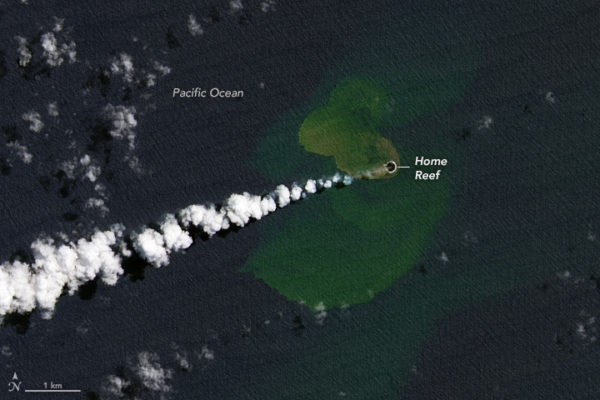After 16 years of profound sleep, a submerged volcano on the seamount known as the Home Reef in the center of the Tonga Islands has awakened and poked its head out of the water.

Out of the Blue (Sea)
On September 10, plumes of steam and ash broke through the waves, and lava and rock pieces started to flow into the water 25 kilometers (15 miles) to the southwest of Late Island.
Within a few days, the pile of rubble had grown into a brand-new island that was 4,000 square meters (one acre) in size and 10 meters (33 feet) tall, according to ScienceAlert.
On September 20, the Tonga Geological Services (TGS) representatives stated that the island had increased in size six times, reaching 24,000 square meters, although scarcely growing any higher.
Before any seafarer would expect to step foot on its rocky coast, this fleeting, unidentified edifice will likely sink back into the Pacific Ocean's scorching "Ring of Fire," like a phoenix emerging from the ashes.
When Home Reef last produced an island in 2006, it took a year for the ocean's waves to destroy the crest.
The crest is substantially shorter this time.
Intense Eruption
The 2006 eruption of the submerged Tonga volcano produced so much debris that a vast raft of the frothy volcanic glass known as pumice was cast adrift over the South Pacific, giving the unsettling look of the land.
Five islands, some of which were between 50 and 70 meters tall, were created by Home Reef in 1852.
The island even sprouted a little lagoon in 1984.
The seamount that produced these transient formations is located in the Tonga-Kermadec subduction zone, home to some of the world's fastest-converging tectonic plates.
Approximately 24 centimeters (9 inches) of the Pacific Plate are sliding beneath the Kermadec and Tonga plates at this location, creating the second-deepest trench in the world and the most active volcanic arc.
The largest concentration of underwater volcanoes discovered on Earth may be found along this extensive undersea ridge that stretches from Tonga to New Zealand.
The construction of the Home Reef's newest island is stunningly detailed in satellite photographs of the most recent eruption.
Using data from the US Geological Survey, NASA published the picture below on September 14.
It revealed a considerable smoke trail and a striking oceanic coloring.
In Constant Monitoring
TGS stated on September 20 that "the volcano poses minor dangers to the aviation community and the communities of Vava'u and Ha'apai."
However, until further notice, "all seafarers are urged to travel beyond 4 kilometers away from Home Reef."
No further volcanic ash or steam has been seen coming from this area of the Pacific since September 25. Home Reef's latest gift to the water is likely finished for the time being, so we should enjoy it while we still can.
Related Article : Exposure to Major Disasters Can Cause Long-Term Mental Health Problems
For more similar, don't forget to follow Nature World News!
© 2025 NatureWorldNews.com All rights reserved. Do not reproduce without permission.





